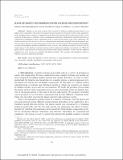Rank-Sparsity Incoherence for Matrix Decomposition
Author(s)
Chandrasekaran, Venkat; Sanghavi, Sujay; Parrilo, Pablo A.; Willsky, Alan S.
DownloadChandrasekaran-2011-RANK-SPARSITY INCOHE.pdf (355.0Kb)
PUBLISHER_POLICY
Publisher Policy
Article is made available in accordance with the publisher's policy and may be subject to US copyright law. Please refer to the publisher's site for terms of use.
Terms of use
Metadata
Show full item recordAbstract
Suppose we are given a matrix that is formed by adding an unknown sparse matrix to an unknown low-rank matrix. Our goal is to decompose the given matrix into its sparse and low-rank components. Such a problem arises in a number of applications in model and system identification and is intractable to solve in general. In this paper we consider a convex optimization formulation to splitting the specified matrix into its components by minimizing a linear combination of the ℓ1 norm and the nuclear norm of the components. We develop a notion of rank-sparsity incoherence, expressed as an uncertainty principle between the sparsity pattern of a matrix and its row and column spaces, and we use it to characterize both fundamental identifiability as well as (deterministic) sufficient conditions for exact recovery. Our analysis is geometric in nature with the tangent spaces to the algebraic varieties of sparse and low-rank matrices playing a prominent role. When the sparse and low-rank matrices are drawn from certain natural random ensembles, we show that the sufficient conditions for exact recovery are satisfied with high probability. We conclude with simulation results on synthetic matrix decomposition problems.
Date issued
2011-06Department
Massachusetts Institute of Technology. Department of Electrical Engineering and Computer Science; Massachusetts Institute of Technology. Laboratory for Information and Decision SystemsJournal
SIAM Journal on Optimization
Publisher
Society for Industrial and Applied Mathematics
Citation
Chandrasekaran, Venkat et al. “Rank-Sparsity Incoherence for Matrix Decomposition.” SIAM Journal on Optimization 21 (2011): 572. © 2011 Society for Industrial and Applied Mathematics.
Version: Final published version
ISSN
1052-6234
1095-7189